
Transcription
INFORMAL INSTITUTIONS AND COMPARATIVEPOLITICS: A RESEARCH AGENDAGretchen Helmke and Steven LevitskyWorking Paper #307 – September 2003
INFORMAL INSTITUTIONS AND COMPARATIVEPOLITICS: A RESEARCH AGENDAGretchen Helmke and Steven LevitskyWorking Paper #307 – September 2003Gretchen Helmke (BA, University of California at Berkeley; PhD, University ofChicago) is an Assistant Professor of Political Science, University of Rochester. Helmkespecializes in comparative political institutions, with a focus on Latin America. Herresearch on formal and informal institutions, decision-making, and the rule of law hasappeared in leading scholarly journals, including the American Political Science Review,Comparative Politics, and Desarrollo Economico. She is currently completing a booklength manuscript entitled Courts Under Constraints: Democracy, Dictatorship, and theArgentine Supreme Court (Cambridge University Press, forthcoming). Her research haswon several awards, including a nomination for the Gabriel A. Almond Award for theBest Dissertation in Comparative Politics (2002) and Honorable Mention for the EdwardC. Corwin Award for the Best Dissertation in Law and Courts (2001). Her research hasbeen funded by the National Science Foundation and the Social Science ResearchCouncil. She is a former fellow of the Fundación Carlos Nino in Buenos Aires,Argentina, the Kellogg Institute for International Studies at the University of NotreDame, and the Academy Scholars Program in the Weatherhead Center for InternationalAffairs at Harvard University.Steven Levitsky is Assistant Professor of Government at Harvard University. His areasof research include political parties and party change, informal institutions, anddemocracy and democratization in Latin America. He is author of Transforming LaborBased Parties in Latin America: Argentine Peronism in Comparative Perspective(Cambridge University Press, 2003). He is currently writing a book on the emergence anddynamics of competitive authoritarian regimes in the post-Cold War era.
ABSTRACTDuring the 1990s, comparative research on political institutions focused primarily onformal rules. Yet recent studies suggest that an exclusive focus on formal rules is ofteninsufficient, and that informal institutions, ranging from bureaucratic and legislativenorms to clientelism and patrimonialism, often have a profound—and systematic—effecton political outcomes. Neglecting these informal institutions thus risks missing many ofthe “real” incentives and constraints that underlie political behavior. This article seeks tomove informal institutions from the margins to the mainstream of comparative politicsresearch. It develops an initial framework for studying informal institutions and,importantly, integrating them into comparative institutional analysis. In the conceptualrealm, the article attempts to clarify what is meant by “informal institution” and thendevelops a typology of four patterns of formal-informal institutional interaction:complementary, accommodating, competing, and substitutive. In the theoretical realm,the article examines two issues that have been largely unexplored in the literature oninformal institutions: the question of why and how informal institutions emerge, and thesources of informal institutions stability and change. A final section explores some of thepractical challenges inherent in research on informal institutions, including issues ofidentification, measurement, and comparison.RESUMENDurante los años 90s la investigación comparativa sobre las instituciones políticas seconcentró primordialmente en las reglas formales. Sin embargo, estudios recientessugieren que un foco exclusivo sobre las reglas formales habitualmente es insuficiente yque las instituciones informales, desde las normas burocráticas y legislativas hasta elclientelismo y el patrimonalismo, suelen tener resultados importantes. Ignorar a estasinstituciones informales entraña así el riesgo de perder de vista muchos de los incentivosy restricciones “reales” que subyacen al comportamiento político. Este artículo procuradesplazar a las instituciones informales desde los márgenes hacia el centro de lainvestigación en política comparada. El texto desarrolla un marco inicial para el estudiode las instituciones informales y, significativamente, para su integración al análisisinstitucional comparativo. En el dominio conceptual, el artículo trata de aclarar qué seentiende por “institución informal” y luego desarrolla una tipología de cuatro patrones deinteracción institucional formal-informal: complementario, adecuador, competitivo ysustitutivo. En el dominio teórico, el artículo examina dos tópicos que no han sidoexplorados en la literatura sobre las instituciones informales: la pregunta acerca de porqué y cómo emergen las instituciones informales, y el problema de las fuentes de laestabilidad y el cambio de las instituciones informales. La sección final explora algunosde los desafíos prácticos inherentes a la investigación sobre las instituciones informales,incluyendo problemas de identificación, medición y comparación.
The 1990s were a decade of institutionalism in comparative politics. Fueled by anunprecedented wave of institutional change in the developing and post-communistworlds, scholars from diverse research traditions turned to studies of how constitutionaldesign, electoral systems, and other formal institutional arrangements affected outcomesranging from economic performance and social policy to the quality and stability ofdemocracy.1Just as these studies were generating new and important theoretical advances,however, other scholars began to point to the limitations of approaches that focusedstrictly on formal institutional design. An emerging body of research on politics in LatinAmerica,2 post-communist Eurasia,3 Africa,4 and Asia5 converged around two keyobservations. First, many outcomes of interest to institutionalists were not adequatelyexplained by formal institutional design. Second, many of the “rules of the game” thatguided political behavior were not found in the formal or written rules; rather, informalconstraints, ranging from legislative norms to patterns of clientelism and patrimonialism,often shaped actors’ incentives in systematic—and robust—ways. These studiesgenerated calls, perhaps most notably from Guillermo O’Donnell, for greater scholarlyattention to “the actual rules that are being followed.”6 O’Donnell and others called theseunwritten rules informal institutions.7The study of informal institutions is hardly new. Informal rules have long been acentral object of study in the field of anthropology, and students of comparative politicshave for decades pointed to stable patterns of political behavior that depart from—andeven undermine—formal institutions.8 Nevertheless, informal institutions have not beenrigorously conceptualized or theorized in comparative politics, and as a result, theyremain at the margins of the contemporary literature on political institutions.The goal of this paper is to move informal institutions from the margins to themainstream of comparative politics research. Our motivation is simple: if social andpolitical actors respond to a mix of “formal and informal constraints,”9 then goodinstitutional analysis requires that scholars examine both sets of rules. By broadening thescope of institutional analysis to include informal rules, scholars can gain a better
understanding of the incentives driving political behavior, which should result in bothbetter research and better theory.10The case for taking informal rules seriously hinges on the impact that those rulescan be shown to have on formal institutional outcomes. If formal institutions (FI) producesimilar outcomes (X) in the presence or absence of a particular informal institution (II),then there is little need to move beyond an exclusive focus on the formal rules.FI ( II) XFI (- II) XHowever, if the presence of an informal institution (II) in a particular formal institutionalcontext (FI) can be shown to produce an outcome (Y) that is distinct from that generatedin its absence (X), then the case for incorporating informal institutions is strengthened.FI (- II) XFI ( II) YAn emerging body of research suggests that informal rules do in fact shapeformal institutional outcomes in significant—and even systematic—ways. Indeed, thesepatterns have emerged in areas that have traditionally been the exclusive domain offormal institutional analysis. We briefly highlight a few of these areas below.Executive-Legislative Relations. Recent studies of presidentialism in newdemocracies suggest that executive-legislative outcomes cannot always be explainedstrictly in terms of constitutional design. Thus, analyses of “neopatrimonial” democraciesin Africa and Latin America have shown how patrimonialist norms of unregulated privatepresidential control over state institutions may result in a degree of executive dominanceover legislative and judicial branches that far exceeds that prescribed by theconstitution.11 Informal institutions may also limit presidential power. For example,despite the fact that Chile’s 1980 Constitution created “one of the most powerfulpresidencies in the world,”12 Chilean presidents systematically underutilized this powerduring the 1990s. According to Peter Siavelis, this outcome is explained by the existenceof “complex network of informal institutions” that encouraged executive consultation andpower-sharing.13Electoral Rules. Informal institutions may also mediate the effects of electoralrules. For example, Michelle Taylor has shown that although Costa Rica’s system of
proportional representation with no legislative re-election creates no incentive forlegislators to perform the kind of constituency service that parties need for their electoralcampaigns, Costa Rican legislators do, in fact, engage in constituency service.14 Taylorattributes this outcome to a set of “informal devices”—such as unofficially-created“districts” and the practice of blacklisting—that encourage party work in the absence of aformal electoral incentive.15 Another example is the relationship between clientelism andcandidate selection. Studies of party primaries in the United States have suggested thatbecause committed voters are more likely to participate, primaries encourage the electionof ideologically extreme candidates.16 Yet this hypothesis rests on the assumption thatprimary voters bring themselves to the polls—an assumption that does not hold in acontext of machine politics. Where clientelism is pervasive, as in Argentina, those whoparticipate in primaries do so because they are induced to vote—and often physicallybrought to the polls—by local brokers.17 As a result, primaries are generally won not bythe most ideologically polarizing candidates, but by the candidates backed by the largestpolitical machine.Judicial Politics. In the realm of judicial politics, Helmke’s study of executivecourt relations in Argentina found that notwithstanding constitutional guarantees oftenure security and judicial independence, Supreme Court justices responded with greaterregularity to an informal institution of tenure insecurity, according to which incoming(democratic and non-democratic) governments were widely expected to stack the court.18The result was a pattern of judicial behavior that departed significantly from thatstipulated by the formal rules.Political Regimes. Finally, informal institutions may have a profound impact onpolitical regimes. For example, Kathleen Collins argues that although the KyrgyzRepublic (a semi-liberal democracy) and Uzbekistan (an autocracy) adopted distinctformal regimes after the collapse of the Soviet Union, the existence of powerful clannetworks pushed the two regimes toward convergence over the course of the 1990s.19According to Collins, clan politics “subverted formal institutions” to such an extent that“informal mechanisms of network-controlled exchange and norms.became the rules ofthe game.”20 As a result, formal regimes became “increasingly de-institutionalized and
inconsequential,” and by the end of the decade, the Kyrgyz Republic and Uzbekistan hadconverged around a single “clan hegemonic” regime type.21Building on this emerging but disparate body of research, this paper develops aframework for studying informal institutions and integrating them into mainstreamcomparative politics research. The paper begins with an effort to clarify the concept of“informal institution.” It argues that informal institutions must be distinguished not onlyfrom formal institutions, but also from a variety of other informal patterns, includingweak institutions, informal behavioral regularities, culture, and informal organizations.The paper then examines the different ways in which formal and informal institutionsinteract. Drawing on the work of Hans-Joaquim Lauth,22 we argue that informal andformal institutions may interact in four distinct ways: complementary, accommodating,competing, and substitutive. Third, the paper explores some key theoretical issues that, todate, remain largely unexplored in comparative politics research on informal institutions.In this section, we examine the question of why and how informal institutions emerge.We then examine different sources of informal institutional stability and change. Thefinal section of the paper discusses some of the challenges that emerge in carrying outresearch on informal institutions, such as issues of identification, measurement, andcomparison.Two initial caveats are in order. First, the focus of this paper is on informalpolitical institutions. Although the term “informal institution” encompasses a wide rangeof social (e.g., the handshake, or the rules of dating) and economic (e.g., black markets)institutions, we confine our discussion to analyses of the political rules of the game.Second, although the article draws examples from a variety of different studies andregions, these are merely illustrative. The article is not intended to be a comprehensivesurvey of the universe of informal institutions.What Informal Institutions Are (and Are Not)The literature on informal institutions encompasses a dizzying array of sociopolitical phenomena. The term “informal institution” has been used to characterizeaspects of traditional culture,23 personal networks,24 clientelism,25 corruption,26 clan and
mafia organizations,27 civil society,28 and a wide variety of legislative, judicial, andbureaucratic norms.29 Such conceptual ambiguity has serious analytic costs, for it limitsour capacity to build and test theories. It is therefore essential that we develop a moreprecise definition of informal institution.We begin with a fairly standard definition of institutions as rules (or sets of rules)that structure social interaction by shaping and constraining actors’ behavior.30 Inconceptualizing “informal institution,” two distinctions are critical. First, informalinstitutions must be distinguished from formal institutions. Second, they must bedistinguished from other, non-institutional, informal patterns and behavior.Formal versus Informal InstitutionsThe distinction between formal and informal institutions has been conceptualizedin several ways. One common distinction is state-societal. According to this approach,“formal institution” refers to state bodies (courts, legislatures, bureaucracies) and stateenforced rules (constitutions, laws, regulations), while “informal institution”encompasses civic, religious, kinship, and other “societal” rules and organizations.31 Aproblem with the state-societal distinction is that it fails to account for a variety ofinformal institutions, including the informal rules that govern behavior within stateinstitutions32 and what Ellickson calls “organization rules,” or the official rules thatgovern non-state organizations such as religious orders, political parties, and interestgroups.33A second distinction centers around the location of rule enforcement. Accordingto this conception, informal institutions—or norms—are self-enforcing institutions, inthat they constitute members of a community’s mutual best response to one another. 34Formal rules, by contrast, are enforced by a third party, usually the state.35 Thisdistinction also misses key informal institutions. For example, it does not allow for thepossibility of informal third party enforcement (mafia bosses may serve as third partyenforcers, but few scholars consider mafias to be formal institutions), or alternatively, forstate enforcement of informal institutions (i.e., organized corruption).36To address these shortcomings, we adopt a third approach. We define formalinstitutions as rules that are openly codified, in the sense that they are established and
communicated through channels that are widely accepted as official. By contrast,informal institutions are socially shared rules, usually unwritten, that are created,communicated, and enforced outside of officially sanctioned channels.37 This distinctioncorresponds to intuitive understandings of formal versus informal, and it converges withthe definitions employed by many leading scholars of formal and informal institutions.38A Second Distinction: What Informal Institutions Are NotYet distinguishing between formal and informal institutions is only half theconceptual task. A potential pitfall of the written versus unwritten distinction is that itrisks treating “informal institution” as a residual category. Potentially, the concept of“informal institution” could encompass virtually all behavior that is not accounted for bythe written-down rules. To avoid this pitfall, it is essential to elaborate further what aninformal institution is not.Four distinctions are worth noting. First, informal institutions must bedistinguished from weak institutions. Many formal institutions are ineffective, in that therules that exist on paper are, in practice, widely circumvented or ignored. Yet formalinstitutional weakness does not necessarily imply the presence of informal institutions. Itmay be that no stable or binding rules—formal or informal—exist, and that politics ischaracterized by extreme fluidity and uncertainty.39 The distinction between weak andinformal institutions can be seen in O’Donnell’s recent work on Latin Americandemocracies. In his seminal article on delegative democracy, O’Donnell argued that inmuch of Latin America, the formal rules of representative democracy are weaklyinstitutionalized.40 In the absence of institutionalized checks on executive power, thescope of permissible presidential behavior widened considerably, which resulted in awidespread abuse of power and frequent political crises. In subsequent work, O’Donnellhighlighted the role of informal institutions, such as clientelism and other forms ofparticularism, in undermining the effectiveness of representative institutions.41O’Donnell’s work points to two distinct patterns of formal institutional weakness thatshould not be conflated. Clientelism and the abuse of constitutionally-defined executiveauthority are both informal in that they depart from formal rules, but whereas the former
pattern is an informal institution, the latter is best understood as non-institutionalbehavior.A second distinction is that between informal institutions and other informalbehavioral regularities. Not all patterned behavior is rule-bound, or rooted in sharedexpectations about others’ behavior.42 Behavioral regularities may be products of avariety of other incentives. To be considered an informal institution, a behavioralregularity must respond to an established rule or guideline, the violation of whichgenerates some kind of external sanction. To cite an example offered by Daniel Brinks,43the pattern of removing one’s coat in a restaurant—as opposed to removing one’s hat inchurch—is a product of a common response to physical discomfort, not a social norm. Inpractice, it is often difficult to distinguish informal rule-bound behavior from otherinformal behavioral regularities. For example, public graft is clearly informal behavior,but only some patterns of corruption should be considered institutions. Where graft isorganized and enforced from above,44 or where it is so widely known and practiced that itis expected of public officials,45 corruption may indeed be institutionalized. Yet in manycases, widespread graft is neither externally sanctioned nor rooted in shared expectations,but rather is a common individual response to other incentives, such as low public sectorsalaries and weak mechanisms of enforcement.Third, informal institutions should be distinguished from the broader concept ofculture. Many scholars have pointed to the role of culture in shaping informalinstitutions,46 and the frontier between “informal institutions” and culture is a critical areafor research. In our view, however, the best way to pursue this agenda is to cast informalinstitutions in relatively narrow terms. Specifically, we argue for a cognitive approachthat defines “informal institution” in terms of shared expectations rather than sharedvalues. Distinguishing between shared values and shared expectations allows us toanalyze potential causal relationships between culture and informal institutions, such aswhether societal values reinforce or undermine particular informal institutions.Finally, informal institutions should be distinguished from informalorganizations. Although scholars often incorporate organizations into their definition ofinstitution,47 it is useful, following North, to separate the “rules” from the “players.”48 Justas formal organizations (such as political parties or trade unions) may be distinguished
from formal institutions, informal organizations such as clans, mafias, and kinshipnetworks should be distinguished from informal institutions. Nevertheless, informal rulesmay be embedded within these organizations, and just as formal political organizationsare widely studied within the overall rubric of “institutionalism,”49 clans, mafias, andother informal structures may be usefully incorporated into informal institutionalanalysis.How Formal and Informal Institutions InteractOnce we have defined formal and informal institutions, we can begin to analyzethe ways in which they interact. A casual survey of the literature on informal institutionsreveals two starkly different characterizations of the interaction between formal andinformal rules. On the one hand, many studies treat informal institutions as playing afunctional or problem-solving role. Thus, norms are cast as solutions to problems ofsocial interaction and coordination,50 and informal rules are seen to enhance the efficiencyor performance of complex institutions.51 On the other hand, another strand of scholarshipcasts informal institutions as primarily dysfunctional or problem-creating. These studieshighlight phenomena—such as clientelism, corruption, patrimonialism, and clanpolitics—that undermine the performance of markets, states, democratic regimes, andother formal institutions.52 As we shall see, however, recent studies suggest a somewhatmore complex story, in which informal institutions at times reinforce or substitute for thevery formal institutions they appear to be undermining.Building on the work of Hans-Joachim Lauth,53 this section develops a typologyaimed at capturing—and making sense of—these differences. The typology is based ontwo dimensions. The first is that of the effectiveness of the relevant formal institutions.Whereas some informal institutions operate in a context of effective formal institutions inwhich the rules are routinely enforced and complied with, others exist in a context ofweak or ineffective formal institutions in which non-compliance routinely goesunsanctioned. The second dimension is that of the degree of compatibility betweenactors’ goals (i.e., what they seek to accomplish through a particular informal institution)and their expectations about the likely outcomes generated by formal institutions.
Whereas in some contexts actors’ goals are similar to or compatible with expected formalinstitutional outcomes, in other contexts actors pursue goals that are at odds with thoseoutcomes. These two dimensions can be combined to produce the four-fold typologyshown in Figure 1. Whereas the types located in the upper-left (complementary) andlower-right (competing) cells correspond to the “functional” and “dysfunctional” typesthat predominate in much of the literature, the typology yields two additional types(accommodating and substitutive) that help to provide a more complete picture of theuniverse of informal institutions.FIGURE 1A TYPOLOGY OF INFORMAL INSTITUTIONSEffective FormalInstitutionsIneffective FormalInstitutionsCompatible GoalsComplementarySubstitutiveConflicting GoalsAccommodatingCompetingComplementary Informal Institutions. The left side of the table corresponds toinformal institutions that co-exist with effective formal institutions, such that actorsexpect that the rules that exist on paper will in fact be enforced. In the upper left corner,which combines effective formal institutions and compatible goals, we have what Lauthcalls “complementary” informal institutions.54 Complementary informal institutionsgenerally “fill in the gaps” left by formal institutions—addressing problems orcontingencies that are not explicitly dealt with in the formal rules—without violating theoverarching formal rules. Hence, they are often said to enhance the performance orefficiency of the relevant formal institution. Examples of complementary informalinstitutions include the many norms, routines, and operating procedures that allowbureaucracies and other complex organizations to function effectively.55 Thus, DonaldMatthews called attention to the various “folkways” of the US Senate (such asapprenticeship, specialization, and courtesy), without which “the Senate could hardly
operate with its present organizational form.”56 Similarly, congressional norms such asthe seniority system and deference to committees are said to enhance legislativeproductivity and contribute to US legislators’ re-election goals,57 and the opinionassignment procedures and the “Rule of Four” are said to facilitate the work of the USSupreme Court.58Accommodating Informal Institutions. The lower left corner of Figure 1, whichcombines effective formal institutions and conflicting actor goals, corresponds to whatmight be called accommodating informal institutions. Accommodating informalinstitutions can be viewed as a “second best” strategy for actors who dislike outcomesgenerated by the formal rules but are unable to change or openly break those rules.59 Theyviolate the spirit, but not the letter, of the formal rules, generally by tempering ormodifying the effects of those rules. In so doing, they often help reconcile key actors’interests with existing formal institutional arrangements. Hence, althoughaccommodating informal institutions may not be efficiency- or performance-enhancing,they at times, albeit unintentionally, enhance the stability or sustainability of formalinstitutions by dampening demands for change.An example of accommodating informal institutions is the informal powersharing arrangements created by the post-Pinochet governing elite in Chile. Leaders ofthe Democratic Concertation inherited an “exaggeratedly strong presidential system” anda majoritarian electoral system that ran counter to their goal of maintaining a broadmultiparty coalition.60 Unable to change the authoritarian-era Constitution, Concertationelites created a set of informal procedures aimed at counteracting its effects. Thesearrangements “enhanced coalitional trust” in a constitutional setting that “provided veryfew incentives for cooperation.”61 Another example is the “informal devices” created byCosta Rican party leaders to induce legislators to engage in constituency service despitethe ban on re-election.62 These informal arrangements comply with the electoral law whileat the same time seeking to counteract its effects. Finally, norms of lax enforcement thathelp reconcile laws that are politically difficult to change with particular economicrealities, such as demand for migrant labor, or social realities, such as prostitution orabortion, can also be seen as fitting into this category. An example is the Dutch practice
of gedogen, a widely known and accepted practice in which criminal law is not fullyenforced on certain issues, such as soft drugs and euthanasia.63Competing Informal Institutions. The right side of Figure 1 corresponds toinformal institutions that co-exist with weak or ineffective formal institutions. In thelower right corner, which combines weak formal institutions and antagonistic goals, arecompeting informal institutions. Competing informal institutions structure actors’incentives in ways that are incompatible with the formal rules: to follow one rule, actorsmust violate another. Examples include clientelism, patrimonialism, clan politics, andother particularistic institutions.64 For example, in his study of Ghana’s publicadministration, Robert Price found that most civil servants believed they would pay asignificant social cost (such as a loss of standing in the community) if they adhered tobureaucratic rules at the expense of kinship group norms under which they wereobligated to provide jobs and other favors to their families and villages.65 Someindigenous or custom laws also compete with formal institutions. As scholars of legalpluralism have shown, the imposition of European legal systems created “multiplesystems of legal obligation” in many post-colonial societies.66 Indigenous and Europeanlegal systems often “embodied very different principles and procedures,”67 which meantthat in some instances, adherence to custom law required that indigenous people violatestate law.Substitutive Informal Institutions. Finally, the upper ri
rigorously conceptualized or theorized in comparative politics, and as a result, they remain at the margins of the contemporary literature on political institutions. The goal of this paper is to move informal institutions from the margins to the mainstream of comparative politics research. Our motivation is simple: if social and










